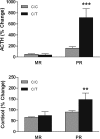Functional CRH variation increases stress-induced alcohol consumption in primates
- PMID: 19706546
- PMCID: PMC2732884
- DOI: 10.1073/pnas.0902863106
Functional CRH variation increases stress-induced alcohol consumption in primates
Abstract
Corticotropin-releasing factor (CRF), encoded by the CRH gene, is a key integrator of stress responses, and, as such, CRH gene variation may contribute to individual differences in susceptibility to stress-related pathology. In rhesus macaques, a single nucleotide polymorphism (SNP) is found within the CRH promoter (-248C--> T). Here, we assessed whether this variant influenced stress responding and, because increased CRF system activity drives alcohol drinking in rodents, we examined whether it predicted voluntary alcohol consumption as a function of prior stress exposure. Using a hypothalamic nuclear extract, we showed that the -248 T allele resulted in increased DNA protein interactions relative to the C allele. In vitro, the T allele resulted in CRH promoter activity that was higher following both stimulation with forskolin and treatment with dexamethasone. Endocrine and behavioral responses to social separation stress (release of ACTH and cortisol, and suppression of environmental exploration, respectively) were higher among carriers of the T allele, particularly among those exposed to early adversity in the form of peer rearing. We also found that T allele carriers with a history of early life adversity consumed more alcohol in a limited-access paradigm. Our data suggest that CRH promoter variation that confers increased stress reactivity increases the risk for alcohol use disorders in stress-exposed individuals.
Conflict of interest statement
The authors declare no conflict of interest.
Figures






References
-
- Owens MJ, Nemeroff CB. Physiology and pharmacology of corticotropin-releasing factor. Pharmacol Rev. 1991;43:425–473. - PubMed
-
- Vale W, Spiess J, Rivier C, Rivier J. Characterization of a 41-residue ovine hypothalamic peptide that stimulates secretion of corticotropin and beta-endorphin. Science. 1981;213:1394–1397. - PubMed
-
- Sapolsky RM. In: Behavioral Endocrinology. Becker J, Breedlove S, Crews D, McCarthy M, editors. Cambridge, MA: MIT Press; 2002. pp. 409–450.
-
- Vale W, et al. Chemical and biological characterization of corticotropin releasing factor. Recent Prog Horm Res. 1983;39:245–270. - PubMed
-
- Heinrichs SC, Koob GF. Corticotropin-releasing factor in brain: A role in activation, arousal, and affect regulation. J Pharmacol Exp Ther. 2004;311:427–440. - PubMed
Publication types
MeSH terms
Substances
Grants and funding
LinkOut - more resources
Full Text Sources
Medical

